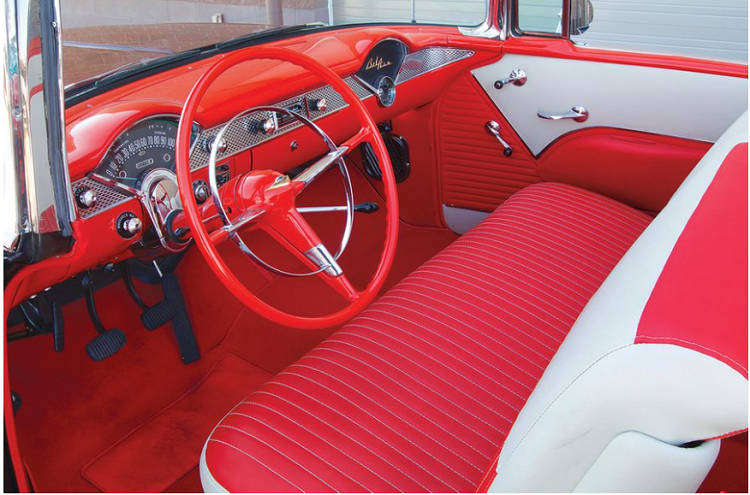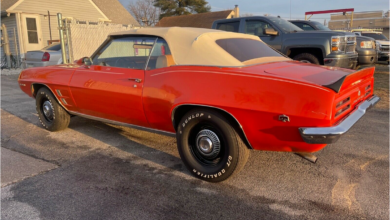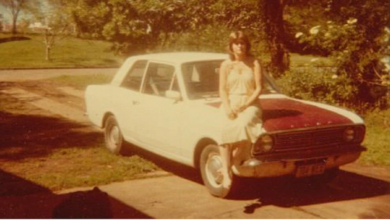Chevy’S 1955-1957 Passenger Cars Remain The Aspirational American Ideal Of A Better Future Now.
The idea of a truly all-new car is tempting fate. Each system, each individual component requires so much effort to work properly in concert with a thousand other components, in myriad conditions, that body/chassis and drivelines often see their launches staggered. A newly styled car, or one with an all-new chassis, often starts life with a carryover powertrain; a new engine may show up in an existing chassis years into a model’s gestation. Doing it all at once is an expensive gamble.
That said, if anyone could launch an all-new car, it was Chevrolet. Its status as America’s best-selling car brand for the bulk of the postwar era brought success and swagger. For 1955, Chevy needed a new car to keep up with the competition’s advances—and the division’s engineers and stylists delivered; Chevy’s V-8-powered 1955 sedan lineup really was as new as it got in Detroit in the ’50s. Comparing the 1954 and ’55 Chevy lines, virtually the only things that remained were the conventional front-engine/rear-drive layout, names (150, 210, Bel Air, et al), the chassis’ 115-inch wheelbase, and the wheel-and-tire combo. All-new body, all-new chassis, all-new V-8 engine, and new optional overdrive behind the (admittedly extant) three-speed manual transmission. You’d scarcely believe a ’54 and a ’55 Bel Air were built a model year apart.
All-new for the fall of 1954, Chevrolet’s full-size line was lower, cleaner, lighter, and more powerful than the previous year’s Chevrolet. While the Chevy bowtie appears prominently on the hood and hubcaps, the Chevrolet name doesn’t appear on the exterior of the car.
Visuals first. Chevy’s new body was actually an inch narrower than the ’54’s—but because the ’55 convertible was 2½ inches lower (and wagons 5-plus inches lower!), the new car looked wider. Yet headroom was comparable, despite the lower roofline. A wrap-around “Sweep-Sight” windshield arrived, as did 18 percent more glass area for better visibility across the lower fenders. Crisp, almost formal lines made for a cleaner profile, with a minimum of filigree: just an elegant spear on 150 and Bel Air models, all the better to outline the optional two-tone paint offerings. The 1954’s ornate grille was exchanged for a tight egg-crate pattern. Fender tops hooded the headlamps; this, the side trim and the rakish rooflines combined to make the Chevy appear to strain against its leash and demand to run at full speed.
Yes, the ancient 235-cubic-inch Blue Flame Six remained—available with manual transmission and 123 horsepower, or 136 ponies with Powerglide. But Chevy’s clean-sheet V-8 was the big news. Engineered by future GM president Ed Cole, Corvette-world legend Zora Arkus-Duntov, and a handpicked group of engineers, it was a wonder of high-tech simplicity. It featured a strong thin-wall block, using up-to-date casting techniques; an over-square bore/stroke that allowed it to rev; five main bearings; forged steel crankshaft; individual stamped-steel rocker arms; interchangeable heads; and self-lubricating hydraulic lifters. Chevy’s V-8 started off modest—162 horsepower for a standard two-barrel 265 with 8:1 compression, although the optional Power Pack (with four-barrel carb and dual exhaust) was rated at 180 horses; the rare Corvette-sourced 195-hp Super Power Pack added the famous Duntov cam and higher-compression pistons. Each V-8 block was painted a vivid shade of orange, so that no one could miss it when the hood was raised.
Wraparound instrument panel and windshield, three-spoke steering wheel with 360-degree horn ring, and centrally-located glovebox give this three-on-the-tree Bel Air an of-the-moment atmosphere.
The 1955’s low-slung, double-drop chassis was 50 percent stiffer than the ’54 frame, Chevy claimed. Engines sat lower in that chassis, for a lower center of gravity, and the front track was 1.3 inches wider. All of these aided handling, despite the carryover 6.7 x 15 tires. The front suspension geometry was designed to limit front-end dive during hard braking, making these cars safer as well. New smoother ball-race steering was now available with optional one-finger power assist. Tubeless tires. Available air conditioning. Pedals that moved from the floor to dangling from the instrument panel above. An easily reached, centrally mounted glovebox. Twelve-volt electrics. On wagons, a rear seat that folded completely flat. Thin pillars to help eliminate blind spots. All were new to Chevrolet. There was even weight savings: a 1954 Bel Air convertible had a shipping weight of 3,445 pounds, while a ’55 listed at just 3,315.
Bel Air had been Chevrolet’s top trim level since 1953; for ’55, buyers could choose from two-door sedan, two-door hardtop, two-door convertible (pictured here), two-door Nomad wagon, four-door sedan, or four-door Beauville wagon. Bel Air trim added full interior carpet, stainless trim atop the front wheel openings, full wheel covers, three-spoke steering wheel, and other trim spiffs. Convertibles were exclusive to the Bel Air line.It’s easy to see why Chevy buyers were so impressed— lower, lighter, quicker, better handling, more comfortable… who could argue with improvements like this? It didn’t even cost a lot more: at $2,206 for a ’55 Bel Air convertible, it was less than 1 percent more than a comparable ’54. Even in high-zoot Bel Air drop-top form, the ’55 Chevy felt like a tremendous value. Buyers recognized this and flocked to their Chevy stores. A whopping 773,238 high-line Bel Airs of all body styles sold for ’55—a 59-percent increase over ’54. A total of 41,292 convertibles were built, a 113-percent sales bump over ’54. With total ’55 Chevy sales around the 1.7-million mark, the most ever for any carmaker up to that point, Chevy’s gamble paid off: Its new car was a smash hit that remains legendary even today. What’s more, its sales achievement lasted until 1962—when the first Boomer kids got driver’s licenses.
“Don’t mess with success” is a wise cautionary mantra, but Chevrolet had already put the finishing touches on its ’56 models by the time it realized what a hit it had. Styling was evolutionary: A new full-width grille helped give an even-wider look to the ’56, despite its unchanged dimensions. Newly shaped side trim, kicking up to the beltline mid-window and sloping down over the rear wheel opening to the bumper, suggested forward motion even more than the ’55s. The gas filler moved from the driver’s-side rear quarter to behind the driver’s-side taillight. Inside, the Chevrolet Bowtie motif cut into the wrap-around dash was replaced by rectangular slots. And Chevy introduced a new body style: the four-door Hardtop Sport Sedan, sans B-pillar, which had a strong debut season selling 103,000 copies.
The base six and two-barrel 265 V-8 were largely unchanged (save for an integral oil filter added to all V-8 blocks for ’56). A new four-barrel, 9.25:1-compression Super Turbo Fire V-8 was rated at 205 horsepower and was shared with the Corvette. Also shared with the Corvette was a 225-hp 265 outfitted with dual four-barrel carbs, a solid-lifter camshaft, dual-point distributor and cylinder heads with larger ports. The high-lift “Duntov” cam was also available, but few were ordered.
Despite the new four-door hardtop, overall Bel Air production dipped 13½ percent, to 669,000 units for 1956. However, convertible sales of 41,268 were nearly identical to the previous season—a negligible percentage loss.
If it ain’t broke, why fix it? Save for door panels and upholstery patterns, the ’56 interior was largely a carryover from 1955. This example is an automatic with power brakes and aftermarket lap belts.
Customers could be fooled into thinking that Chevrolet had eschewed its traditional three-year plan with the ’57 passenger-car line—at least Chevy hoped so; it was a significant-enough refresh that some assumed that it was really all-new once again. Cars boasted new sheetmetal, now with tailfins, and a new interior, with reorganized gauge cluster. Headlamp eyebrows helped direct fresh air into the vents that surrounded the lights and into the cabin. The airplane-motif hood ornament became a pair of decorative jet engine-style intakes. But there were functional changes as well: the cowl, for example, was 1½ inches lower, for improved visibility.
Bel Airs were now more obviously separated from their 150 and 210 siblings by a new side spear that started as a trim line on the front fenders and doors, and then quickly spread and triangulated to the back of the car, making the baby fins look even more dramatic. New 7.50 x 14 tires became standard. There was also a name change: The four-door wagon variant was christened Townsman, a name previously attached to the 210-line’s four-door wagon; it swapped places with the Beauville appellation.
Powertrains were refreshed, of course. The 8:1-compression Blue Flame Six remained for the miserly, but most plumped for a selection of V-8s: the carryover 265 two-barrel, or one of four new 283-cu.in. models: the 8.5:1 compression, two-barrel Turbo-Fire 283, the four-barrel, 9.5:1-compression Super Turbo-Fire, the Corvette V-8 (the Super Turbo Fire engine with an extra four-barrel carburetor added on), and—also borrowed from Corvette, and only available with manual transmission—a 283 with Rochester mechanical fuel injection, 10.5:1 compression and mechanical lifters that offered 1 horsepower per cubic inch. Some early 265-cube engines were painted chartreuse, while later 265s and other V-8s were orange.
An all-new instrument panel, with a round speedo replacing the previous seashell shape, backs a two-spoke tiller. Far edges of the dash are now raised; too many complaints of smashed knees?
Sales jumped. For 1957, a total of 702,220 Bel Airs rolled out of Chevrolet factories and showrooms—a 5-percent gain on the year before. Convertible production rose to 47,562—a 15-percent rise over the ’56 season. And yet … Ford smoked Chevy in the overall sales race by 10 percent: 1.676 to 1.507 million. The Bel Air, that enduring icon, was a sales loser in its day. What’s more, comparing sales with Ford’s high-line Fairlane Sunliner (and in ’57, Fairlane 500 Sunliner) convertibles, the Tri-Five Bowtie soft-top never topped the Blue Oval’s crosstown rivals: Fairlane ragtop sold 17 percent better than Bel Air in 1955; 29 percent better in ’56; and in ’57, when Ford’s convertible ascended to the new Fairlane 500 range, Sunliner outsold the Bel Air ragtop by 39 percent.
But facts and history have only tangential bearing on what makes a car iconic. And make no mistake, Chevy’s 1955-‘57 passenger car lineup is as iconic as it gets. To come up with something all-new, to hit an out-of-the-park grand slam, and for it to remain in our nation’s collective memory decades after most of the people who bought these cars new have slipped their mortal bonds? Unheard of. And yet the Tri-Five Chevy era remains iconic—for Chevy, for America, for eternity.















Thanks very interesting blog!
That’s very good point